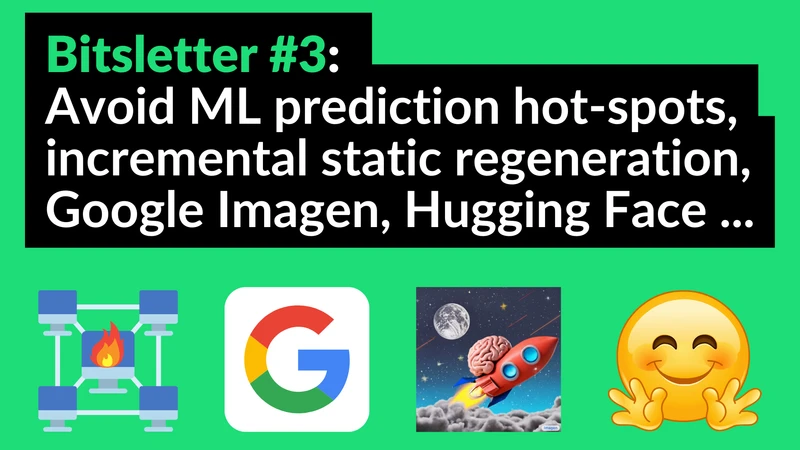Bitsletter #3: Cluster Load Balancing, Incremental Web Updates, & Matrix Magic

🧠 ML Tip: Avoid inference hot-spots on your machine learning clusters
If you deploy machine learning models with an API access, you likely encountered scaling issues. Ideally, you don't want the API server facing your clients to make the predictions, since CPU intensive tasks on web servers will rapidly increase your latency. One solution is to use a machine learning cluster, dedicated to inference in production. However, if your model accepts batches of inputs, it's not a good idea to send all the inputs to the same node. Indeed, if your API receive a large batch and send it to a single node, it could paralyze this node for long time. These kind of hot-spots on your infrastructure can impact seriously the prediction latency.
One solution is to split the batch over the nodes to have an almost equal load on every nodes, maximizing the parallel computing power of your cluster. To do so you need to take care of the outputs sequence, or you could return predictions out of order. A simple solution is to associate a key to each group of data you send to the cluster, then each node will return the outputs as well as the corresponding key. For example you receive a batch (a,b,c,d,e,f), you split it into 3 batches (1,a,b), (2,c,d), (3,e,f). Then even if you receive predictions in mixed order like (3, pred_e, pred_f), (1, pred_a, pred_b), (2, pred_b, pred_c), you can send the prediction to the client in the proper order (pred_a, pred_b, pred_c, pred_d, pred_e, pred_f).
🌐 Web Tip: Incremental Static Regeneration (ISR)
The JavaScript, APIs, and Markup (JAMstack) is a popular architecture for web development. It works by entirely pre-rendering your website into static pages, and deploy them using an efficient CDN for super-fast delivery. Static here doesn't mean only HTML and CSS, you can also ship some JavaScript with you web pages and fetch data or call services on the client side if needed.
The main benefits of this architecture are:
- Security & Scale: no backend to secure and you only have to serve static files. Using a global CDN like CloudFlare you can scale infinitely.
- Performance: pages are pre-rendered so the browser will display them in a glimpse, also the code is split between each pages for a faster loading time.
However there is one catch: if your website has thousands of pages, for every change you need to rebuild all the pages and it can take some time. Incremental Static Regeneration is a solution to this problem. In this architecture, you can refresh static pages after you've built your site. Developers and content editors can use static generation, per-pages, without rebuilding the entire site.
You can define a re-validation time per page, and the your pages will be re-built at run time at this fixed interval. The cache will be automatically invalidated so your CDN can start serving the refreshed page. So if the content on your CMS changed for a specific page, it will be updated after the re-validation time without re-building the entire site.
Now you can pre-render only the most visited pages, reducing the build time, and let the incremental static regeneration handle the rest. Modern frameworks like NextJS support this feature.
👩🔬 Research Paper: Multiplying Matrices Without Multiplying
Multiplying matrices is the fundamental building block of machine learning. Although we are getting faster and faster (thanks to accelerators like GPUs and optimized libraries), we need to improve even more: model complexity keeps increasing, and lots of applications require real-time processing. Let’s leave the realm of exact multiplications, and move to approximated matrix multiplication: sacrifice precision for speed.
Usual techniques first use linear functions to project the matrices into a space with a special structure suitable for fast multiplication (e.g. leverage sparsity). Then they multiply the transformed matrices: the problem is reduced to exact matrix multiplication. The paper introduces MADDNESS, a technique employing a non-linear transformation to reduce the problem to table lookups. In the special case where one matrix is known in advance, MADDNESS doesn’t use any multiply-add operations. This is usually the case at inference when you already know your model weight matrix.
The technique is close to vector quantization, but the authors introduce a quantization function which doesn’t use any multiplication: it relies on hashing, averaging, and byte shuffling which are super fast CPU operations. The paper claims to be 100x faster than exact multiplication and 10x faster than the existing approximate methods. They even have an open source implementation on GitHub.
🛠 Tool: Gradio, a tool for machine learning and data science demos
Gradio is a tool to easily build demos for data science and machine learning applications. It's important to show your progress early in machine learning or data science project for many reasons:
- Agile development: deliver value fast, and quickly iterate
- Get inputs and remarks from as may stakeholders as possible
- Attract users early in the development process
- …
However it can be daunting and time-consuming for data scientists to build themselves a demo web application serving for their models. Gradio main features:
- Fast and easy setup: you can install it with pip
- Present and share: works in Notebooks or web applications
- Permanent hosting: free and permanent hosting on Hugging Face Spaces
📰 News
Google Imagen: Text-to-Image Diffusion Model
Google released Imagen, a new text-to-image diffusion model. It uses a super-resolution diffusion architecture, and achieve impressive image quality and text fidelity. Imagen is a direct competitor to the OpenAI DALL-E 2 model.
Hugging Face Reaches $2 Billion Valuation
Hugging Face is a community driven platform with many repositories for machine learning models, datasets and ML applications. Using Spaces you can even demo machine learning easily in web apps. They are becoming a must for machine learning practitioners, and so achieving the great valuation of $2 billion.
